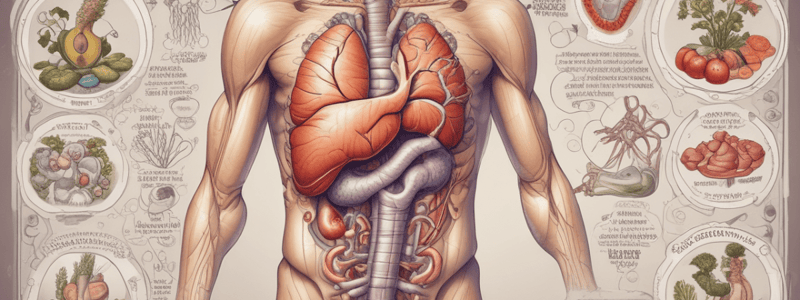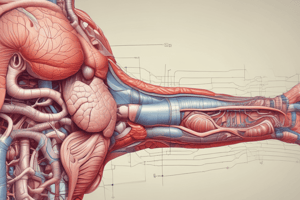Podcast
Questions and Answers
What does the visceral peritoneum cover?
What does the visceral peritoneum cover?
- Only the body wall
- The outside of the stomach
- The intestines and other viscera (correct)
- The dorsal mesentery
Which organ is found dorsal to the liver when raised?
Which organ is found dorsal to the liver when raised?
- Stomach (correct)
- Duodenum
- Gallbladder
- Spleen
What is the function of the gallbladder?
What is the function of the gallbladder?
- To store bile (correct)
- To absorb nutrients
- To secrete digestive enzymes
- To produce bile
What structure supports the stomach and is a part of the dorsal mesentery?
What structure supports the stomach and is a part of the dorsal mesentery?
What region of the stomach is nearest to the esophagus?
What region of the stomach is nearest to the esophagus?
Which ducts combine to form the common bile duct?
Which ducts combine to form the common bile duct?
What type of cavity is the pleuroperitoneal cavity?
What type of cavity is the pleuroperitoneal cavity?
What connects the digestive tract to the median dorsal line?
What connects the digestive tract to the median dorsal line?
Which of the following is NOT a function of the digestive system?
Which of the following is NOT a function of the digestive system?
What is the correct order of sections in the digestive tract?
What is the correct order of sections in the digestive tract?
Which accessory organ is primarily responsible for producing bile?
Which accessory organ is primarily responsible for producing bile?
What is the primary role of the teeth in the digestive process?
What is the primary role of the teeth in the digestive process?
Which section of the digestive tract is primarily involved in nutrient absorption?
Which section of the digestive tract is primarily involved in nutrient absorption?
In which part of the digestive system does the elimination of undigested remains primarily occur?
In which part of the digestive system does the elimination of undigested remains primarily occur?
The maxillary teeth are primarily associated with which function?
The maxillary teeth are primarily associated with which function?
Which structure directly follows the esophagus in the digestive tract?
Which structure directly follows the esophagus in the digestive tract?
What is the primary reason for obtaining oxygen from the environment?
What is the primary reason for obtaining oxygen from the environment?
Which of the following correctly describes internal respiration?
Which of the following correctly describes internal respiration?
Which respiratory organ is NOT utilized by frogs and toads?
Which respiratory organ is NOT utilized by frogs and toads?
What characteristic of the respiratory organs in frogs facilitates gas exchange?
What characteristic of the respiratory organs in frogs facilitates gas exchange?
What term describes the process of gas exchange between the environment and the respiratory organs?
What term describes the process of gas exchange between the environment and the respiratory organs?
In the context of respiration, what role does carbon dioxide play?
In the context of respiration, what role does carbon dioxide play?
What is the significance of the Eustachian tube openings in frogs?
What is the significance of the Eustachian tube openings in frogs?
Which step should be performed first when studying the respiratory system of a toad?
Which step should be performed first when studying the respiratory system of a toad?
What is the primary function of the pancreas as described?
What is the primary function of the pancreas as described?
Which structure is referred to as a common passageway for both digestive and urogenital systems?
Which structure is referred to as a common passageway for both digestive and urogenital systems?
What anatomical feature of the stomach allows for expansion and contraction?
What anatomical feature of the stomach allows for expansion and contraction?
In which part of the digestive system does the ileum terminate?
In which part of the digestive system does the ileum terminate?
What is the role of the mesentery proper as mentioned in the content?
What is the role of the mesentery proper as mentioned in the content?
What is the anatomical location of the duodenum in relation to the pylorus?
What is the anatomical location of the duodenum in relation to the pylorus?
Where is the spleen located in relation to the stomach?
Where is the spleen located in relation to the stomach?
Which of the following best describes the position of the pancreas?
Which of the following best describes the position of the pancreas?
What is the purpose of inserting the probe into the external nares?
What is the purpose of inserting the probe into the external nares?
Where do the openings of the Eustachian tube lead to?
Where do the openings of the Eustachian tube lead to?
What is located ventral to the esophagus?
What is located ventral to the esophagus?
What anatomical structure is referred to as the linea alba?
What anatomical structure is referred to as the linea alba?
When making an incision in the rectus abdominis muscle, what should be avoided?
When making an incision in the rectus abdominis muscle, what should be avoided?
What should be done after making an incision in the chest area according to the procedure?
What should be done after making an incision in the chest area according to the procedure?
Which of the following structures is located behind the mouth?
Which of the following structures is located behind the mouth?
What anatomical landmark is made using scissors to initiate an abdominal incision?
What anatomical landmark is made using scissors to initiate an abdominal incision?
Flashcards are hidden until you start studying
Study Notes
Digestive System Overview
- The digestive system converts food into basic nutrients for energy, growth, development, and repair.
- Key functions include ingestion, digestion (physical and chemical), absorption of nutrients, and elimination of undigested waste.
- Divided into the digestive tract (alimentary canal) and accessory organs.
Sections of the Digestive Tract
- The digestive tract consists of the mouth, oral cavity, pharynx, esophagus, stomach, small intestine, large intestine, and anus/cloaca.
- Accessory organs aiding digestion include teeth, tongue, salivary glands, liver, gallbladder, and pancreas.
Dissection Procedure: Gross Anatomy of the Digestive Tract
- Start with a preserved toad and dissecting materials.
- Open the mouth to examine the buccal cavity and identify:
- Upper and lower lip folds.
- Maxillary teeth along the upper jaw and vomerine teeth on the roof of the mouth.
- Internal nares leading from the external nares.
- Eyeball prominences and openings of the Eustachian tube.
- The tongue is attached at the floor of the mouth; pharynx leads to the esophagus.
Dissection Steps
- Make incisions to expose the abdominal cavity, revealing the pericardial cavity (heart) and pleuroperitoneal cavity (lungs and organs).
- Identify the parietal peritoneum lining the body wall and its extension forming the visceral peritoneum over the intestines.
- Mesenteries support the digestive tract, with dorsal mesentery attaching to the median dorsal line.
Key Organs in the Pleuroperitoneal Cavity
- The liver is large and trilobed, with the gallbladder storing bile produced by the liver.
- The stomach, located dorsal to the liver, has three regions: cardiac, fundus, and pyloric regions.
- The pancreas is a yellowish gland in the mesentery that produces digestive enzymes and bicarbonates.
Structure of the Small and Large Intestine
- The small intestine begins from the pylorus, with the first section being the duodenum, followed by the coiled ileum.
- The large intestine ends in the rectum, which connects to the cloaca, a common passage for digestive and urogenital systems.
Respiratory System Overview
- Respiration involves obtaining oxygen for metabolism and expelling carbon dioxide.
- It consists of external respiration (gas exchange between the environment and respiratory organs) and internal respiration (gas exchange within body tissues).
- Frogs and toads use lungs, skin, and the mouth lining for respiration.
Dissection Procedure: Gross Anatomy of the Respiratory System
- Examine the preserved toad's oral cavity for respiratory features:
- Nostrils (external nares) lead to internal nares.
- Eustachian tube openings are located at the roof of the oral cavity.
Objectives of Activities
- Identify digestive tract sections and accessory organs involved in digestion.
- Recognize respiratory organs and understand airflow during respiration in frogs.
Studying That Suits You
Use AI to generate personalized quizzes and flashcards to suit your learning preferences.




